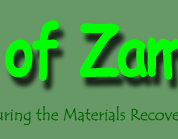



|
THE PROCESS
WHAT IS COMPOSTING?
Composting is "organized rotting" where nutrients and moisture is returned to the soil. Rotting is accomplished by microbes, fungi and other organisms 'digesting' the decaying material and converting it into a soil-rich conditioner or compost. If correctly done, compost is free from unpleasant odors, manageable and can be stored for long periods for later use.
Many composters
have discussed the importance of special inocula (bacterial activators),
supposedly containing several pure strains of laboratory organisms or
other biological factors essential to decompose organic matter and fix
nitrogen, They call them "enzymes," "hormones,"
"preserved living organisms," "activated factors,"
"biocatalyst," etc. In fact, several commercial composting
processes are built around the use of some special inoculum, often known
only to its discoverer and proponent, who claims it to be fundamental
to the successful operation of the process. The need for inocula have
always been debatable, and most composting studies have strongly indicated
that they are unnecessary. The terms "biocatalyst" and "activated
factors" are applied to various biological materials which are
supposed to activate and accelerate decomposition and stabilization
of organic material.
Environmental impacts of composting
Use of compost as a soil conditioner, a fertilizer, or a growth medium has, of course, significant environmental benefits. In addition to returning nutrients to the soil and thus permitting the reduction of artificial fertilizers, compost is waste that does not have to be landfilled. When it is used as daily cover at landfills, it replaces other materials that would otherwise be used for that purpose.
Catalysts and Innocula
Catalysts purport to degrade odorous compounds, usually via biologically generated enzymes. A catalyst facilitates a reaction without itself being permanently changed by the reaction, and thus each enzyme can act on many molecules of an odorous compound before it is eventually degraded. Enzymatic catalysts are normally applied either on the surface of a compost pile or in the airspace above it. Many composters have discussed the importance of special inocula (bacterial activators), supposedly containing several pure strains of laboratory organisms or other biological factors essential to decompose organic matter and fix nitrogen, They call them "enzymes," "hormones," "preserved living organisms," "activated factors," "biocatalyst," etc. In fact, several commercial composting processes are built around the use of some special inoculum, often known only to its discoverer and proponent, who claims it to be fundamental to the successful operation of the process. The terms "biocatalyst" and "activated factors" are applied to various biological materials which are supposed to activate and accelerate decomposition and stabilization of organic material.
THE PROCESS:
- Preparation
of Dumping Pit
- Unloading
of garbage
- Spraying
of germicidal
- Mixing
with coco dust
- Loading
into Hooper
- Trommel
to loosen solid waste
- Conveyor
where separation is made
- Hammer
milling
- Loading
on composter drum
- Mixing
with lactobacilli enzyme
- Unloading
of compost
- Sun
drying of compost
- Screening
and bagging
During
the year, the Honorable City Mayor, thru Executive Order L-95-2002 dated
July 31, 2002, created the Solid Waste Management Board, pursuant to
Section 12 of RA 9003, composed of the following:
Vice-Chairman :
City General Services Officer
Member :
Chairman, Committee on Health & Sanitation of the
Sangguniang Panlungsod
Member :
President, Liga ng Mga Barangay of his representative
Member :
Chairperson of the Sangguniang Kabataan Federation or his representative
and, Representative(s) from the NGO concerned with the protection of
air and water quality, the Recycling Industries, the Manufacturing or
Packaging Industry, and from each concerned government agency with relevant
technical and marketing expertise.
About Us | Project Narrative | Cooperating Agency | Contact Us
Process in Action
 -
Spraying of Germicidal
-
Spraying of Germicidal

Mixing with Coco dust

Loading to Hooper

Trommel to loosen waste

Conveyor/Segregation

Hammer-milling

Loading to Composter Drum

Mixing with Lactobacilli

Unloading of compost

Sun-drying of compost

Screening of dried compost

Bagging of compost
Click here to view images in zoom view





